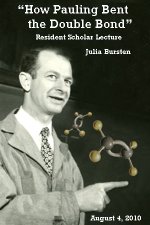Abstract

“How Pauling Bent the Double Bond” Watch Video
Bursten's talk focuses upon a specific aspect of Linus Pauling's valence theory of chemical bonds - the development of his ideas on the bent equivalent bond, or "banana bond" as it is sometimes called.
In his early writings on structural chemistry, Pauling posited that chemical bonds could be represented as tetrahedra that are, roughly speaking, pressed together. Pauling wrote extensively in support of this theory, though focuses much of his attention on single bonds. Aside from a brief mention in a 1931 paper, Pauling's only other early reference to the bent equivalent bond was a short passage in the first (1939) edition of The Nature of the Chemical Bond, in which Pauling again reiterated his position in support of the merged tetrahedra.
As with most of Pauling's structural chemistry work, this picture of the double bond was generally accepted for several years. Gradually though, Pauling's valence approach began to come under attack by a group of scientists supporting the molecular orbital model of chemical bonds, in part because the mathematics underlying the molecular orbital model were much simpler to apply than the techniques utilized by Pauling.
Bursten traces Pauling's response to these criticisms as they played out over the late 1950s and in the third edition of The Nature of the Chemical Bond (1960). The evidence suggests that 1960 marked Pauling's final major defense of his valence theory of the bent equivalent bond and over time the molecular orbital approach gained the continued favor of the scientific community.
Related Names: Linus Pauling


